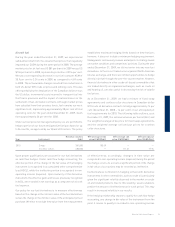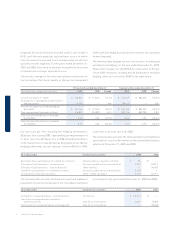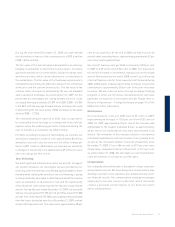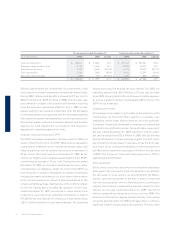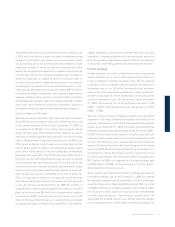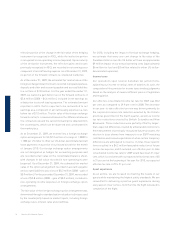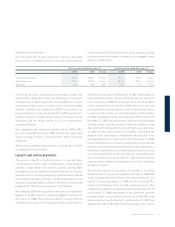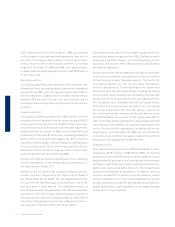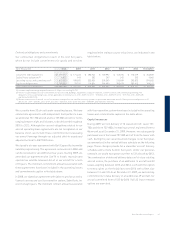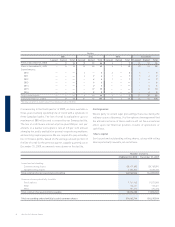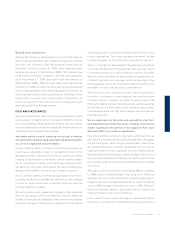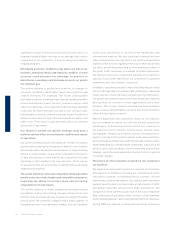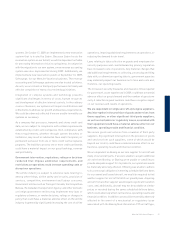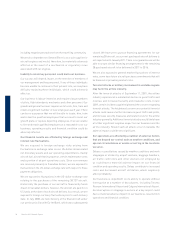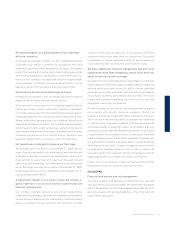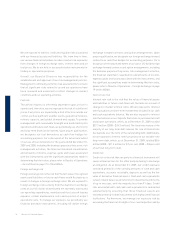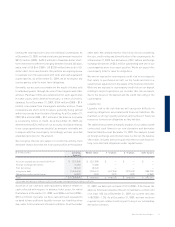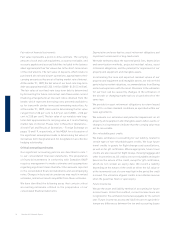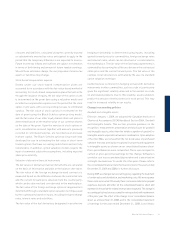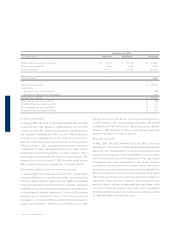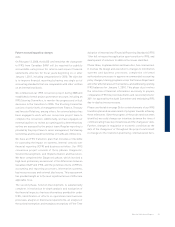Westjet 2009 Annual Report Download - page 55
Download and view the complete annual report
Please find page 55 of the 2009 Westjet annual report below. You can navigate through the pages in the report by either clicking on the pages listed below, or by using the keyword search tool below to find specific information within the annual report.
WestJet 2009 Annual Report 25
might sustain, which could have a material adverse effect on our
results of operations. There is no assurance that we will be able
to obtain insurance on the same terms as we have in the past.
There is a risk that the Government of Canada may not continue
to provide indemnity for third party war risk coverage, which
it currently provides to certain scheduled carriers, including
WestJet. In the event that the Government of Canada does not
continue to provide such coverage, such coverage may or may
not be available to us in the commercial markets, and the costs
and impact of such costs are, as yet, undetermined.
The London aviation insurance market has announced its
intention to introduce a new standard war and terrorism
exclusion clause to apply to aircraft hull, spares, guest and
third party liability policies that will exclude claims caused by
the hostile use of a dirty bomb, electromagnetic pulse device
or biochemical materials. Any such changes could increase our
potential exposure.
We are dependent on the price and availability of jet fuel.
Continued periods of high fuel costs, volatility of fuel prices
and/or signifi cant disruptions in the supply of fuel could
adversely affect our results of operations.
Fuel price volatility continues to represent a signifi cant risk, as
the cost of fuel has been at historically elevated levels throughout
the past few years, and is largely unpredictable. Fuel prices
are impacted by a host of factors outside our control, such as
signifi cant weather events, geopolitical tensions, refi nery capacity
and global demand and supply. A small change in the price of
fuel can signifi cantly affect profi tability. Our ability to react to fuel
price volatility may be delayed and affected by factors outside
our control.
Although fuel prices were lower overall during 2009 as compared
to 2008, prices remained higher than long-term historical
averages. Our fuel costs constitute our largest single expense
category, representing approximately 28 per cent of operating
costs in 2009 and approximately 36 per cent in 2008. Therefore,
the price of fuel has impacted, and could continue to impact, the
timing and nature of our growth initiatives.
In the event of a fuel supply shortage or signifi cantly higher
fuel prices, a curtailment of scheduled service could result. A
Related-party transactions
We have debt fi nancing and investments in short-term deposits
with a fi nancial institution that is related through two common
directors, one of whom is also the president of the fi nancial
institution. As at December 31, 2009, total long-term debt
includes an amount of $6.4 million (2008 – $7.3 million) due
to the fi nancial institution. Included in cash and cash equivalents,
as at December 31, 2009, are short-term investments of
$143.3 million (2008 – $96.5 million) owing from the fi nancial
institution. In 2008, we signed a three-year revolving operating
line of credit agreement with a banking syndicate, of which one
of the members is the related-party fi nancial institution. These
transactions occurred in the normal course of operations on
terms consistent with those offered to arm’s-length parties and
are measured at the exchange amount.
RISKS AND UNCERTAINTIES
The airline industry has inherent risk associated with it to which
we are subject, including, but not necessarily limited to, the risk
factors listed below. Management performs a risk assessment
on a continual basis to ensure that signifi cant risks related to our
airline have been reviewed and assessed.
Any major safety incident involving our aircraft or similar
aircraft of other airlines could materially and adversely affect
our service, reputation and profi tability.
A major safety incident involving our aircraft during operations
could cause substantial repair or replacement costs to the
damaged aircraft, a disruption in service, signifi cant claims
relating to injured guests and others, and a negative impact
on our reputation for safety, all of which may adversely affect
our ability to attract and retain guests. We have an Emergency
Response Plan (ERP) in the event of an incident occurring.
An air carrier’s liability is limited by applicable conventions,
including the Montreal and Warsaw Conventions. Any changes
to these or other conventions or treaties could increase our
potential liabilities to guests.
We carry insurance with comparable coverage to other scheduled
airlines operating in the North American market. While we
believe our insurance is adequate, there can be no assurance
that such coverage will fully protect us against all losses that we


